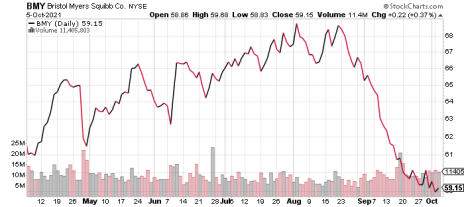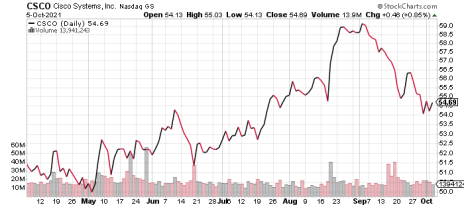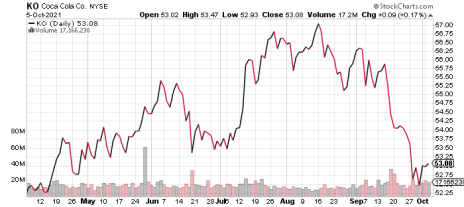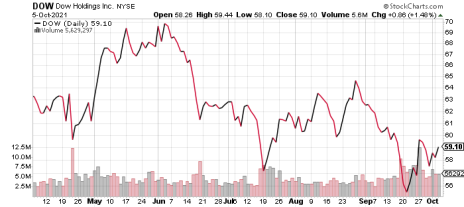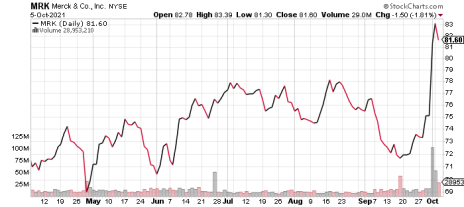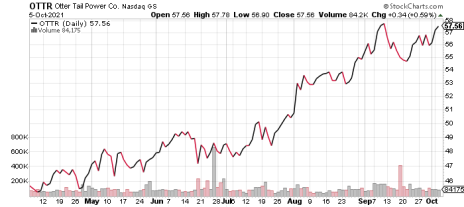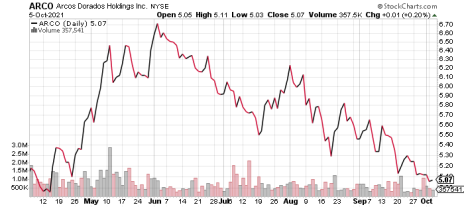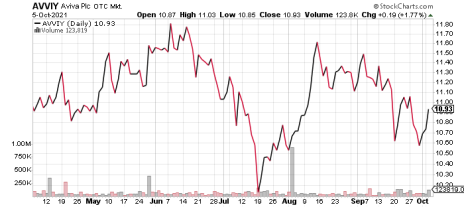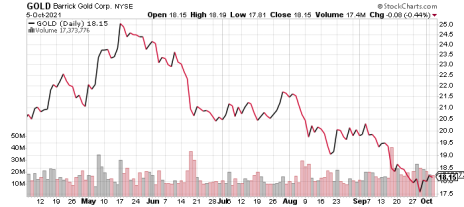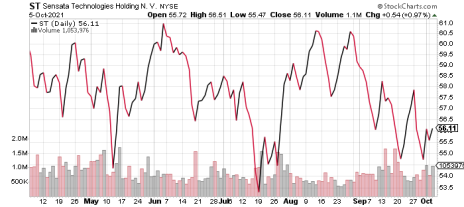Thank you for subscribing to the Cabot Undervalued Stocks Advisor. We hope you enjoy reading the October 2021 issue.
Volatility is a value/contrarian investors’ friend. With the markets becoming more volatile, we’ve made some changes to the portfolio this past month. We recently added ConocoPhillips (COP), a major oil and gas producer that is also an undervalued cash flow machine at current commodity prices.
Market Overview
Dishwashers and Coin Clipping
In our vacation house in New Hampshire (for those not familiar with our tale, this is a 90-year-old un-insulated wood-frame house with decades-old but not antique furniture and appliances), our 20-year-old KitchenAid dishwasher finally conked out. Replacing it with a comparable model will cost around $1,200. We’re not sure how much our older model cost when it was new, but we believe it was somewhere around $780.
The current cost is about 54% more than the estimated original cost. This implies an 2.2% annual inflation rate. Not bad, especially considering that the new models are more energy-efficient and have fancy features like interior LED lighting and high-tech settings like ProWash™ and PrintShield™. But, from a basic functionality perspective, there is essentially no difference. Perhaps we should be satisfied with our new machine, and the relatively modest inflation in its cost. But we’re not.
It’s clear that the new machine will be of lower quality. The metal isn’t quite as rugged, there is more plastic, and it looks like KitchenAid cut some corners to keep the cost down. It seems highly unlikely to last for 20 years. The stats-keepers at the U.S. Bureau of Labor Statistics calculate that the cost of appliances like dishwashers fell at a -0.54% annual rate over the past 20 years. But in my real-world example, this clearly isn’t the case. The BLS numbers are used in official inflation data, so if this quality and price problem is widespread (we believe that it is), then inflation measures like the Consumer Price Index understate real-world inflation. The clipping away of quality, while charging the same or higher price, is a form of debasement.
In the olden days, when kings and governments minted coins made of gold and silver, people were tempted to shave tiny amounts off the edges of the coins, thus stealing some value for themselves. If done carefully, the coin could be passed along at face value, yet be not quite of the same quality. Interestingly, this is a reason why many coins have textures or words on their rims. Coin clipping is a more brazen form of debasement than our dishwasher example, but the effect is the same.
In terms of appliances and other manufactured products, debasement may be a perfectly acceptable way to keep things affordable for millions of Americans, as manufacturing them with the same quality could mean doubling their price. But, in terms of currencies, the cumulative effect of debasement is inflation – the increase in price of exactly the same item.
Inflation, and currency debasement, is a lot higher than the official statistics indicate.
Official inflation numbers are, of course, starting to rise quickly. The August CPI increased 5.3% from a year ago (even as the housing component continues to significantly understate inflation). Curiously, major appliance makers are curtailing production of their lower-priced models to prioritize their more expensive and higher-margin models – this won’t be good for keeping inflation rates low.
Consumer inflation expectations are ramping up as well. The Federal Reserve Bank of New York’s survey for August showed that consumers are expecting an inflation rate of 4.0% in the medium term – well-above the 2% rate targeted by the Fed.
If inflation surges, how do investors protect the value of their assets? There don’t appear to be any great answers - we certainly not experts, but we are looking at this problem a lot more closely.
Separately, while we’re not one to trumpet short-term performance, we thought the last week’s market move was informative. For the week through Monday, the average share price for our Buy-rated stocks rose about 1.2%, compared to a 1.2% decline for the S&P 500. While just a brief snapshot in time, the 2.4% favorable performance gap illustrates the benefits of the group’s value focus.
Share prices in the table reflect Tuesday (October 5) closing prices. Please note that prices in the discussion below are based on mid-day October 5 prices.
Note to new subscribers: You can find additional color on past earnings reports and other news on recommended companies in prior editions and weekly updates of the Cabot Undervalued Stocks Advisor on the Cabot website.
Send questions and comments to Bruce@CabotWealth.com.
Today’s Portfolio Changes
Otter Tail Corporation (OTTR) – Moving from Buy to Hold.
Portfolio changes during the past month
ConocoPhillips (COP) – New Buy
General Motors (GM) – Raising from Hold to Buy
Dow (DOW) – Raising from Hold to Buy
Growth & Income Portfolio
Growth & Income Portfolio
Growth & Income Portfolio stocks are generally higher-quality, larger-cap companies that have fallen out of favor. They usually have some combination of attractive earnings growth and an above-average dividend yield. Risk levels tend to be relatively moderate, with reasonable debt levels and modest share valuations.
| Growth/Income Portfolio | |||||||
| Stock (Symbol) | Date Added | Price Added | 10/5/21 | Capital Gain/Loss | Current Dividend Yield | Price Target | Rating |
| Bristol-Myers Squibb (BMY) | 04-01-20 | 54.82 | 59.15 | 7.9% | 3.3% | 78.00 | Buy |
| Cisco Systems (CSCO) | 11-18-20 | 41.32 | 54.69 | 32.4% | 2.6% | 60.00 | Buy |
| Coca-Cola (KO) | 11-11-20 | 53.58 | 53.08 | -0.9% | 3.1% | 64.00 | Buy |
| Dow Inc (DOW) * | 04-01-19 | 53.50 | 59.10 | 10.5% | 4.7% | 78.00 | Buy |
| Merck (MRK) | 12-9-20 | 83.47 | 81.60 | -2.2% | 3.2% | 99.00 | Buy |
| Otter Tail Corporaton (OTTR) | 5-25-21 | 47.10 | 57.56 | 22.2% | 2.7% | 57.00 | Hold |
Bristol Myers Squibb Company (BMY) shares sell at a low valuation due to worries over patent expirations for Revlimid (starting in 2022) and Opdivo and Eliquis (starting in 2026). However, the company is working to replace the eventual revenue losses by developing its robust product pipeline while also acquiring new treatments (notably with its acquisitions of Celgene and MyoKardia), and by signing agreements with generics competitors to forestall their competitive entry. The likely worst-case scenario is flat revenues over the next 3-5 years. Bristol should continue to generate vast free cash flow, helped by a $2.5 billion cost-cutting program, and has a relatively modest debt level.
Merck has reached an agreement to acquire Acceleron Pharmaceuticals (XLRN) for $180/share in cash, with a total price of $11.5 billion. Bristol-Myers will receive cash for its 7 million XLRN shares, which we estimate will generate pre-tax proceeds of about $1.26 billion. Bristol will continue to receive 20% royalties on all future sales of sotatercept while also paying low-20% royalties to Merck on Reblozyl sales.
It’s a bit curious why Bristol didn’t win this company. There almost certainly was a bidding war, which we may learn about in subsequent regulatory filings, but for some reason Bristol let Merck win. Did the price get too high? Did Bristol need Acceleron less than Merck?
BMY shares fell 1% in the past week and have about 31% upside to our 78 price target.
We continue to believe that most of the downward pressure on BMY shares is due to worries over new drug price controls in the $3.5 trillion infrastructure bill, although progress on this piece of the bill appears to have stalled recently. However, the exact scope and depth of the proposals won’t be known until at least after the bill is passed (if it is passed). Many investors simply avoid pharma stocks during such a period. We are a bit more optimistic that Congress won’t gut the industry, in part due to the impressive strength of the pharma lobby, and remain patient with BMY shares with strong conviction in the company’s underlying fundamentals.
The stock trades at a low 7.4x estimated 2022 earnings of $8.03 (unchanged in the past week) and 7.0x estimates of $8.46 (up a cent) for 2023. Either we are completely wrong about the company’s fundamental strength, or the market must eventually recognize Bristol’s earnings stability and power. We believe the earning power, low valuation and 3.3% dividend yield that is well-covered by enormous free cash flow make a compelling story. BUY
Cisco Systems (CSCO) is facing revenue pressure as customers migrate to the cloud and thus need less of Cisco’s equipment and one-stop-shop services. Cisco’s prospects are starting to improve under a relatively new CEO, who is shifting Cisco toward a software and subscription model and is rolling out new products, helped by its strong reputation and entrenched position within its customers’ infrastructure. The company is highly profitable, generates vast cash flow (which it returns to shareholders through dividends and buybacks) and has a very strong balance sheet.
There was no significant company-specific news in the past week.
CSCO shares slipped 1% in the past week and have about 9% upside to our 60 price target.
The shares trade at 16.0x estimated FY2022 earnings of $3.43 (unchanged in the past week). On FY2023 earnings (which ends in July 2023) of $3.68 (unchanged), the shares trade at 14.9x. On an EV/EBITDA basis on FY2022 estimates, the shares trade at a 11.2x multiple. CSCO shares offer a 2.7% dividend yield. We continue to like Cisco. BUY
Coca-Cola (KO) is best-known for its iconic soft drinks yet nearly 40% of its revenues come from non-soda beverages across the non-alcoholic spectrum. Its global distribution system reaches nearly every human on the planet. Coca-Cola’s longer-term picture looks bright but the shares remain undervalued due to concerns over the pandemic, the secular trend away from sugary sodas, and a tax dispute which could cost as much as $12 billion (likely worst-case scenario). The relatively new CEO James Quincey (2017) is reinvigorating the company by narrowing its oversized brand portfolio, boosting its innovation and improving its efficiency, as well as improving its health and environmental image. Coca-Cola’s balance sheet is sturdy, and its growth investing, debt service and dividend are well-covered by free cash flow.
Coca-Cola announced that it will introduce its new global brand advertising platform, “Real Magic,” on October 11. We’re generally unimpressed with new advertising initiatives, although Coke is skilled in keeping its brand relevant in a positive way and we assume this new platform will continue its reputation.
KO shares rose 1% in the past week and have about 20% upside to our 64 price target.
While the valuation is not statistically cheap, at 21.9x estimated 2022 earnings of $2.43 (unchanged this past week) and 20.4x estimated 2023 earnings of $2.61 (unchanged), the shares remain undervalued given the company’s future earning power and valuable franchise. Also, the value of Coke’s partial ownership of a number of publicly traded companies (including Monster Beverage) is somewhat hidden on the balance sheet, yet is worth about $23 billion, or 9% of Coke’s market value. This $5/share value provides additional cushion supporting our 64 price target. KO shares offer an attractive 3.2% dividend yield. BUY
Dow Inc. (DOW) merged with DuPont to create DowDuPont, then split into three companies in 2019 based on product type. The new Dow is the world’s largest producer of ethylene/polyethylene, the most widely used plastics. Investors undervalue Dow’s hefty cash flows and sturdy balance sheet largely due to its uninspiring secular growth traits and its cyclicality. The shares are driven by: 1) commodity plastics prices, which are often correlated with oil prices and global growth, along with competitors’ production volumes; 2) volume sold, largely driven by global economic conditions, and 3) ongoing efficiency improvements (a never-ending quest of all commodity companies). Investors worry about a cyclical peak and whether Dow will squander its vast free cash flow. We see Dow as having more years of strong profits before capacity increases signal a cyclical peak, and expect the company to continue its strong dividend, reduce its pension and debt obligations, repurchase shares slowly and restrain its capital spending.
There was no significant company-specific news in the past week.
Dow will host an investor day on October 6, starting at 10am ET, which will be accessible via the Dow investor relations website. We will provide our commentary in next week’s letter.
Dow shares were flat this past week and have 32% upside to our 78 price target. On estimated 2022 earnings of $6.03 (unchanged in the past week), the shares trade at a 9.8x multiple. On estimated 2023 earnings of $5.53 (down about 2%), the shares trade at about 10.7x.
Analysts are somewhat pessimistic about 2022 earnings (they assume a 29% decline from 2021). If the 2022 estimate resumes it upward march, the shares will likely follow, although Dow’s cyclical earnings and investor fears of an eventual downcycle will ultimately limit Dow’s upside. The high 4.7% dividend yield adds to the shares’ appeal – especially in a low-interest-rate environment. In a prolonged downcycle, the dividend could be cut, but that could be years away and even then a cut isn’t a certainty if Dow can manage its balance sheet and down-cycle profits reasonably well. BUY
Merck (MRK) shares are undervalued as investors worry about Keytruda, a blockbuster oncology treatment (about 30% of revenues), facing generic competition in late 2028. Also, its Januvia diabetes treatment may see generic competition next year, and like all pharmaceuticals it is at risk from possible government price controls. Yet, Keytruda is an impressive franchise that is growing at a 20% rate and will produce solid cash flow for nearly seven more years, providing the company with considerable time to replace the potential revenue loss. Merck’s new CEO, previously the CFO, will likely accelerate Merck’s acquisition program, which adds both return potential and risks to the story. The company is highly profitable and has a solid balance sheet. It spun off its Organon business in June and we think it will divest its animal health sometime in the next five years.
Merck has reached an agreement to acquire Acceleron Pharmaceuticals (XLRN) for $180/share in cash, with a total price of $11.5 billion. If the deal is not completed under some conditions, Merck will receive a $345 million break-up fee, and a fee of between $650 million and $750 million if the deal is rejected for anti-trust reasons. Bristol-Myers will continue to receive 20% royalties on all future sales of sotatercept while also paying low-20% royalties to Merck on Reblozyl sales.
Merck said the deal will be minimally dilutive to EPS in 2022, then turn significantly accretive afterwards. We see this as a reasonable, as Merck is paying for the acquisition with non-earning cash and low-interest debt, setting easy hurdles for it to be non-dilutive. For the years after 2022, Merck is assuming that Acceleron’s treatments become sizeable revenue producers, certainly possible but not guaranteed.
While some of the deal will be financed with debt, and Merck said on the conference call that they would accept a one-notch credit rating downgrade, Merck has not closed the door on future acquisitions. However, we think it unlikely that they will do another $11 billion+ deal anytime soon.
The deal is larger than what we expected from Merck, but helps move them away from reliance on Keytruda. As an early-stage company, with its sotatercept heart treatment yet to receive FDA approval, Acceleron’s future is somewhat binary. If the treatment receives FDA approval, the estimated $180/share deal price would be a stunning bargain. However, failure could mean the shares are worth maybe $50, producing a large and relatively quick loss for Merck. FDA approval might be a year or more away.
Separately, Merck said that it is considering pressing the FDA to authorize for emergency use Merck’s Covid treatment, molnupiravir. The treatment, different from a vaccine, would help alleviate symptoms in patients that already have contracted Covid. The potential size of this market, and the chances of any FDA approval or early authorization, are difficult to gauge.
Merck shares rose a sizeable 12% this past week (largely on the news surrounding the Covid treatment) and have about 21% upside to our 99 price target. Valuation is an attractive 12.6x estimated 2022 earnings of $6.49 (up about 1% this past week) and 11.7x estimated 2023 earnings of $7.04 (up about 2%). We note that Keytruda’s patent expiration doesn’t happen until late 2028. If the company produces earnings close to these estimates and continues to provide evidence of solid post-Keytruda prospects, as we expect, the shares are considerably undervalued.
Merck produces generous free cash flow to fund its current dividend (now yielding 3.2%) as well as likely future dividend increases, although its shift to a more acquisition-driven strategy will slow the pace of increases. BUY
Otter Tail Corporation (OTTR) is a rare utility/industrial hybrid company, with a $2 billion market cap. The electric utility has a solid and high-quality franchise, with a balanced mix of generation, transmission and distribution assets that produce about 75% of the parent company’s earnings, supported by an accommodative regulatory environment. The industrial side includes the Manufacturing and Plastics segments. Otter Tail has an investment-grade balance sheet, produces solid earnings and prides itself on steady dividend growth. The unusual utility/manufacturing structure is creating a discounted valuation, which might make the company a target for activists, as the two parts may be worth more separately, perhaps in the hands of larger, specialized companies.
There was no significant company-specific news in the past week.
OTTR shares rose 2% this past week and have reached our 57 price target. We are now putting OTTR shares under review for either a higher price target or a sell rating, and moving them to a HOLD for now.
The stock trades at about 16.0x estimated 2021 earnings of $3.59 (unchanged). On estimated 2022 earnings of $3.13 (unchanged), the shares trade at about 18.3x. Analysts are assuming that the plastics upcycle will fade in 2022, weighing on earnings by about 13%. OTTR shares offer a 2.7% dividend yield. HOLD
Buy Low Opportunities Portfolio
Buy Low Opportunities Portfolio
Buy Low Opportunities Portfolio stocks include a wide range of value opportunities, often with considerable upside. This group may include stocks across the quality and market cap spectrum, including those with relatively high levels of debt and a less-clear earnings outlook. The stocks may not pay a dividend. In all cases, the shares will trade at meaningful discounts to our estimate of fair value.
| Buy Low Opportunities Portfolio | |||||||
| Stock (Symbol) | Date Added | Price Added | 10/5/21 | Capital Gain/Loss | Current Dividend Yield | Price Target | Rating |
| Arcos Dorados (ARCO) | 04-28-21 | 5.41 | 5.07 | -6.3% | — | 7.50 | Buy |
| Aviva (AVVIY) | 03-03-21 | 10.75 | 10.93 | 1.7% | 5.4% | 14.00 | Buy |
| Barrick Gold (GOLD) | 03-17-21 | 21.13 | 18.15 | -14.1% | 2.0% | 27.00 | Buy |
| ConocoPhillips (COP) | 9-24-21 | 65.02 | 71.73 | 10.3% | 2.6% | 80.00 | New Buy |
| General Motors (GM) | 12-31-19 | 36.60 | 54.34 | 48.5% | — | 69.00 | Buy |
| Molson Coors (TAP) | 08-05-20 | 36.53 | 48.25 | 32.1% | — | 69.00 | Buy |
| Organon (OGN) | 06-07-21 | 31.42 | 32.53 | 3.5% | — | 46.00 | Buy |
| Sensata Technologies (ST) | 02-17-21 | 58.57 | 56.11 | -4.2% | — | 75.00 | Buy |
Arcos Dorados (ARCO), which is Spanish for “golden arches,” is the world’s largest independent McDonald’s franchisee. Based in stable Uruguay and listed on the NYSE, the company produces about 72% of its revenues in Brazil, Mexico, Argentina and Chile. Arcos’ leadership looks highly capable, led by the founder/chairman who owns a 38% stake. The shares are undervalued as investors worry about the pandemic, as well as political/social unrest, inflation and currency devaluations. However, the company is well-managed and positioned to benefit as local economies reopen, and it has the experience to successfully navigate the complex local conditions. Debt is reasonable relative to post-recovery earnings, and the company is currently producing positive free cash flow.
Macro issues will continue to move ARCO shares. We would like to see stability/strength in the Brazilian currency after its weakness since the pandemic. The pace of vaccinations in Brazil appears to be accelerating, which should boost economic results later this year, likely helping Arcos’ business. The political situation is edgier, as slow job growth increases the pressure on the president, Jair Bolsonaro, in advance of the October 2022 election. See additional comments in our September 1 letter.
There was no significant company-specific news in the past week.
ARCO shares slipped another 1% this past week and have about 48% upside to our 7.50 price target. Investors appear to be playing the macro newsflow about Brazil’s political and economic issues and not the company’s underlying fundamentals. We remain steady in our conviction in the company’s recovery. The low share price offers a chance to add to or start new positions.
The stock trades at 16.9x estimated 2022 earnings per share of $0.30 (unchanged from a week ago). The 2023 consensus estimate of $0.37 (unchanged) implies a 13.7x multiple. BUY
Aviva, plc (AVVIY), based in London, is a major European insurance company specializing in life insurance, savings and investment management products. Amanda Blanc was hired as the new CEO last year to revitalize Aviva’s laggard prospects. She has divested operations around the world to aggressively re-focus the company on its core geographic markets (UK, Ireland, Canada), and is improving Aviva’s product competitiveness, rebuilding its financial strength and trimming its bloated costs. Aviva’s dividend has been reduced to a more predictable and sustainable level with a modest upward trajectory. Excess cash balances are being directed toward debt reduction and potentially sizeable special dividends.
Much of our interest in Aviva is in what it plans to do with its current and future excess capital, including the proceeds from its divestitures. So far, the company has recently raised its interim dividend by 5% to £0.0735/share (about $0.20 per ADS, as there are 2 underlying common shares per ADS, and the exchange rate is about $1.38) and will return at least £4 billion (about $5.5 billion) by 2H 2022, mostly through share buybacks. It will complete £750 million “immediately.” The balance of the divestiture proceeds will go toward debt paydown.
We anticipate that the company will pay a final (year-end) dividend of about twice its interim dividend, for a full-year total recurring dividend of about $0.61/ADS. On this, the shares would produce an annual dividend yield of about 5.7% – rather appealing in an era when AA-rated corporate bonds yield about 1.8%
Aviva closed on several of its major divestitures, including Aviva Italia (£284 million) and Aviva France (£2.8 billion). These completions pave the way toward more dividends and share repurchases.
Aviva shares rose 2% this past week and have about 28% upside to our 14 price target.
The stock trades at 8.8x estimated 2022 earnings per ADS of $1.24 (up 2 cents), which is lower than estimated 2021 earnings due to Aviva’s divestitures. Interestingly, the 2023 estimate is $1.40 (unchanged), implying more than a full recovery from 2021 results. The stock trades at about 96% of tangible book value. BUY
Barrick Gold (GOLD), based in Toronto, is one of the world’s largest and highest-quality gold mining companies. About 50% of its production comes from North America, with the balance from Africa/Middle East (32%) and Latin America/Asia Pacific (18%). The market has little interest in Barrick shares. Yet, Barrick will continue to improve its operating performance (led by its new and highly capable CEO), generate strong free cash flow at current gold prices, and return much of that free cash flow to investors while making minor but sensible acquisitions. Also, Barrick shares offer optionality – if the unusual economic and fiscal conditions drive up the price of gold, Barrick’s shares will rise with it. Given their attractive valuation, the shares don’t need this second (optionality) point to work – it offers extra upside. Barrick’s balance sheet has more cash than debt. Major risks include the possibility of a decline in gold prices, production problems at its mines, a major acquisition and/or an expropriation of one or more of its mines.
The threat of local governments taking control of gold mines remains. As the free world shrinks, autocratic governments become more assertive about taking assets from Western companies. Most of Barrick’s production comes from countries unlikely to expropriate, but takings at the margin will weigh on the shares.
Commodity gold prices rose just over 1% to $1,762/ounce while the 10-year Treasury yield remained unchanged at 1.53%. The U.S. Dollar Index, another driver of gold prices (the dollar and gold usually move in opposite directions) is trading at 93.97, a one-year high, and up about 4.4% from this past May. The index remains about 5% below its pre-Covid late-2019 level of about 99. Gold prices seems rangebound for now.
The market continues to be impatient with gold stocks, in no small part due to rising interest rates. If interest rates keep rising, it certainly is possible that gold prices slip further. As Barrick’s shares are sensitive to gold prices, they are falling farther and faster, and have the possibility of dipping into the mid-teens. Investors not comfortable with this possibility should probably sell their Barrick shares.
Our view is to hang onto Barrick shares, wait until the momentum sellers clear out, then buy more. Fundamentally, the company is doing well and has solid leadership, quality mines and a very strong balance sheet. It might take a long time, but we remain confident that eventually the shares will hit the target price.
Not to get too far into the weeds, but if the U.S. economy stalls out (inevitable at some point), and if/when the stock market tumbles, it seems highly likely that the Fed will return to a zero-rate environment and the federal government will unleash another huge stimulus package. These would probably be an unmitigated positive for gold prices and for Barrick shares.
There was no significant company-specific news in the past week.
Barrick shares were flat this past week and have about 49% upside to our 27 price target. The price target is based on 7.5x estimated steady-state EBITDA and a modest premium to our estimate of $25/share of net asset value.
On its recurring $.09/quarter dividend, GOLD shares offer a reasonable 2.0% dividend yield. Barrick will pay an additional $0.42/share in special distributions this year (no clarity on 2022 special dividends), lifting the effective dividend yield to 4.3%. BUY
ConocoPhillips (COP), based in Houston, Texas, is the world’s largest independent E&P company, with about two-thirds of its production in the United States. The company focuses exclusive on oil and natural gas production, as it spun off its refining and other operations over a decade ago.
Below is the original text from our initial recommendation of COP shares on September 24.
Shares of ConocoPhillips have remained beaten down, despite resilient oil prices, creating an undervalued bargain.
Four issues seem to be weighing on E&P stocks like ConocoPhillips. First, investors are increasingly looking to avoid climate-unfriendly companies. Also, investors have low interest in exposure to volatile and unpredictable oil and gas prices, especially since the entire energy sector has a tiny 2.6% weighting in the S&P 500 index. Another concern is that company managements will lose their new-found capital spending discipline. And, there is always the risk that OPEC+ opens their oil production spigots, sending oil prices down.
Yet, supporting energy prices is resilient demand, which has nearly returned to pre-pandemic levels despite still-subdued jet fuel and gasoline demand. Despite urgent calls for alternative fuels to help mitigate climate change, the challenges to reducing the reliance on carbon-based energy remains daunting, with a wholesale shift likely to be slow-moving and measured in decades.
Subdued supply growth should also support oil prices. Major global energy companies are under increasing pressure to reduce their production to help fight climate change. And, following years of aggressive drilling in the U.S., shale oil’s most productive days may be in the past. If so, domestic production, now running about 15% below 2019 levels, may be permanently lower.
Given this, we see a contrarian opportunity in ConocoPhillips. With the news that it is acquiring Royal Dutch Shell’s Texas assets for $9.5 billion in cash, we believe the time to buy has arrived.
We like Conoco’s low valuation at about 5x EV/EBITDAX1. It also offers a free cash flow yield of close to 12%2 – an indicator of the company’s strong cash production as well as its discounted price. Most analysts have oil prices of perhaps $55-$60/barrel in their earnings estimates, implying that profits and cash flow will be stronger than estimated, as oil has traded close to $70/barrel for most of the year so far.
Conoco’s balance sheet is robust, with an investment-grade balance sheet. While it is spending most of its cash hoard on Royal Dutch Shell’s Texas assets ($9.0 billion cash balance at the end of the second quarter), we see its strong free cash flow leading to a rebuilding of its balance sheet.
Conoco has publicly stated that it will limit its capital spending to 50% of its annual cash flow, even after its Shell purchase. We believe that the management is unlikely to renege on this commitment. For perspective on the size of this cash flow, at $50 oil, the company said the deal would allow for an incremental $10 billion of cash to be returned to investors over the next decade. This is on top of management’s guidance for $65 billion in next-decade cash distributions before the Shell deal. For perspective, Conoco’s market cap is about $76 billion. This is a remarkably attractive prospect, particularly at $70 oil. Conoco shares currently have a dividend yield of about 2.8%, offering a respectable base-level cash inflow to shareholders that appears rock-solid.
We are placing an 80 price target on ConocoPhillips shares. The shares have jumped some on the Texas acquisition news, so investors may want to buy a partial position now, then wait for any pullbacks.
- EV/EBITDAX is Enterprise value to Earnings before interest, taxes, depreciation, amortization and exploration spending. Similar to EBITDA, the EBITDAX is a proxy for cash earnings, which also excludes exploration costs that run through the income statement.
- Free cash flow yield is the company’s cash flow from operations less capital spending, divided by its market capitalization. It is a measure of how much free cash flow is at the company’s disposal after it maintains its business, which can then be used to pay down debt, pay recurring or special dividends and/or repurchase shares.
Updates on ConocoPhillips:
At its meeting on Monday, OPEC+ (which includes Russia) made no changes to its plans to gradually increase oil production. The plan is to increase production by 400,000 barrels per day each month. This appears insufficient to stem the surge in oil prices, which are trading up about 1.5% on Tuesday, to about $78.80 for West Texas Intermediate, and $82.54 for Brent Crude. For our ConocoPhillips position, the ideal scenario would be for oil to remain about where it is. Much higher (perhaps above $90 or $100), and the prices could both threaten the recovery and drillers’ restraint. Much lower (perhaps below $60), ConocoPhillips’ cash flow gusher would look less appealing at the current $72.40/share price.
We estimate that just under 20% of ConocoPhillips’ revenue is generated from natural gas sales. Domestic natural gas prices continue to surge, now trading around $6.20/mmbtu, nearly double the May 2021 price. Exceptionally tight supplies in Europe and Asia are driving up natural gas prices there, which in turn is drawing supply from the United States via LNG exports and helping raise U.S. natural gas prices.
Natural gas previously was an entirely landlocked product, trapped in North America, as there was no feasible way to economically export it across the vast oceans. In a testament to the ingenuity of markets, engineers and investors have developed an export market by super-cooling natural gas into liquid form, called LNG, or liquified natural gas. LNG is loaded on special cargo ships for distribution around the globe. As natural gas currently trades for around $15 in Europe and as high as $32 in Asia, LNG exports can produce exceptional profits. While LNG export volumes are small, they are high enough relative to daily local production to at least partly narrow the price spread.
ConocoPhillips shares rose 6% this past week and have about 11% upside to our 80 price target. The shares trade at 12.5x estimated 2022 earnings of $5.75 (up 2% this past week) and 12.6x estimated 2023 earnings of $5.73 (up 7%).
On its recurring $.46/quarter dividend, COP shares offer a 2.6% dividend yield. BUY
General Motors (GM) is making immense progress with its years-long turnaround. It is perhaps 90% of the way through its gas-powered vehicle turnaround, and is well-positioned but in the early stages of its electric vehicle (EV) development. GM Financial will likely continue to be a sizeable profit generator. GM is fully charged for both today’s environment and the EV world of the future, although the underlying value of its emerging EV business is unclear.
The shares reflect conservative but reasonably strong gas-powered vehicle profits but assign no value to the EV operations. This zero-value almost certainly is wrong but the EV operations have no sales or profits so the valuation is by definition speculative at this point.
Following last week’s news that Swedish electric-car maker Polestar will become a public company (by merging with a SPAC), Volvo Cars, also based in Sweden, announced that it will go public, via a traditional initial public offering. The two companies are connected, as Volvo Cars will own about half of Polestar after its debut. Once public, investors will have a deeper market to help value GM’s electric and other non-traditional gas-powered vehicle operations. Based on initial chatter about the valuations of Polestar and Volvo Cars, GM’s shares should see at least some valuation uplift.
GM said it is investing in next-generation battery technologies, to be centered in a new facility called the Wallace Battery Cell Innovation Center based near Detroit. We assume that GM will continue to press its development of all aspects of EV and autonomous vehicles, yet remain within its stated $35 billion budget. As such, we are less interested in the details of every announcement, rather more focused on the general trajectory of their efforts and spending, and likely won’t comment on future announcements unless we view them as affecting the trajectory of their program.
Engine No. 1, the new activist investment firm that rattled ExxonMobil and its shareholders enough to gain three board seats, has purchased a tiny (<1%) equity stake in GM and is supportive of the company’s EV efforts. The upstart activist said it has had conversations with GM head Mary Barra. Engine No. 1’s interest and confidence has helped push up GM’s shares. The car company will host an investor meeting on Wednesday, October 6 to update investors on its EV initiatives. The update, which starts at 1pm EDT, is viewable live on GM’s website. Curious investors will want to check out Engine No. 1’s website as well – it is an impressive display of marketing savvy.
We will include comments on GM’s investor meeting in next week’s letter.
GM shares rose 3% this past week and have 27% upside to our 69 price target.
On a P/E basis, the shares trade at 7.9x estimated calendar 2022 earnings of $6.90 (unchanged this past week). On estimated 2023 earnings of $6.79 (unchanged), the shares trade at about 8.0x.
The P/E multiple is helpful, but not a precise measure of GM’s value, as it has numerous valuable assets that generate no earnings (like its Cruise unit, which is developing self-driving cars and produces a loss), its nascent battery operations, and its other businesses with a complex reporting structure, nor does it factor in GM’s high but unearning cash balance which offsets its interest-bearing debt. However, it is useful as a rule-of-thumb metric, and provides some indication of the direction of earnings estimates, and so we will continue its use here. We are raising our rating to BUY.
Molson Coors Beverage Company (TAP) is one of the world’s largest beverage companies, producing the highly recognized Coors, Molson, Miller and Blue Moon brands as well as numerous local, craft and specialty beers. About two-thirds of its revenues come from the United States, where it holds a 24% market share. Investors worry about Molson Coors’ lack of revenue growth due to its relatively limited offerings of fast-growing hard seltzers and other trendier beverages. Our thesis for this company is straight-forward – a reasonably stable company whose shares sell at an overly discounted price. Its revenues are resilient, it produces generous cash flow and is reducing its debt. A new CEO is helping improve its operating efficiency and expand carefully into more growthier products. The company recently re-instated its dividend.
There was no significant company-specific news in the past week.
TAP shares rose 2% in the past week, perhaps reflecting that the price is well-below fair value for the company’s steady and improving business.
The shares have about 43% upside to our 69 price target. They trade at 11.2x estimated 2022 earnings of $4.30 (unchanged this past week) and 10.7x estimated earnings of $4.53 (down a cent) in 2023.
On an EV/EBITDA basis, or enterprise value/cash operating profits, the shares trade for about 8.3x estimated 2022 results, still among the lowest valuations in the consumer staples group and below other brewing companies. BUY
Organon & Company (OGN) was recently spun off from Merck. It specializes in patented women’s healthcare products and biosimilars, and also has a portfolio of mostly off-patent treatments. Organon will produce better internal growth with some boost through smart yet modest-sized acquisitions. It may eventually divest its Established Brands segment. The management and board appear capable, the company produces robust free cash flow, has modestly elevated debt and will pay a reasonable dividend. Investors have ignored the company, but we believe that Organon will produce at least stable and large free cash flows with a reasonable potential for growth. At our initial recommendation, the stock traded at a highly attractive 4x earnings.
There was no significant company-specific news in the past week.
OGN shares slipped 1% this past week and have about 40% upside to our 46 price target (using the same target as the Cabot Turnaround Letter). The shares trade at 5.5x estimated 2022 earnings of $5.98 (unchanged in the past week) and 5.3x estimated 2023 earnings of $6.20 (down 1%). Organon shares offer an attractive 3.4% dividend yield. BUY
Sensata Technologies (ST) is a $3.8 billion (revenues) producer of nearly 47,000 highly engineered sensors used by automotive (60% of revenues), heavy vehicle, industrial and aerospace customers. About two-thirds of its revenues are generated outside of the United States, with China producing about 21%. Investors undervalue Sensata’s durable franchise. Its sensors are typically critical components that generally produce high profit margins. Also, as the sensors’ reliability is vital to safely and performance, customers are reluctant to switch to another supplier that may have lower prices but also lower or unproven quality. Sensata has an arguably under-leveraged balance sheet and generates healthy free cash flow. The relatively new CEO will likely continue to expand the company’s growth potential through acquisitions.
Once a threat, electric vehicles are now an opportunity, as the company’s expanded product offering (largely acquired) allows it to sell more content into an EV than it can into an internal combustion engine vehicle. Risks include a possible automotive cycle slowdown, chip supply issues, geopolitical issues with China, currency and over-paying/weak integration related to its acquisitions.
There was no significant company-specific news in the past week.
ST shares were flat this past week and have about 34% upside to our 75 price target.
The stock trades at 13.5x estimated 2022 earnings of $4.14 (unchanged this past week) and 12.1x estimated 2023 earnings of $4.63 (unchanged). We expect this 2023 estimate will move around a lot. On an EV/EBITDA basis, ST trades at 10.6x estimated 2022 EBITDA. BUY
Disclosure: The chief analyst of the Cabot Undervalued Stocks Advisor personally holds shares of every recommended security, except for “New Buy” recommendations. The chief analyst may purchase or sell recommended securities but not before the fourth day after any changes in recommendation ratings has been emailed to subscribers. “New Buy” recommendations will be purchased by the chief analyst as soon as practical following the fourth day after the newsletter issue has been emailed to subscribers.
Strong Buy – This stock offers an unusually favorable risk/reward trade-off, often one that has been rated as a Buy yet the market has sold aggressively for temporary reasons. We recommend adding to existing positions.
Buy – This stock is worth buying.
Hold – The shares are worth keeping but the risk/return trade-off is not favorable enough for more buying nor unfavorable enough to warrant selling.
Sell – This stock is approaching or has reached our price target, its value has become permanently impaired or changes in its risk or other traits warrant a sale.
Note for stock table: For stocks rated Sell, the current price is the sell date price.
The next Cabot Undervalued Stocks Advisor issue will be published on November 3, 2021.

